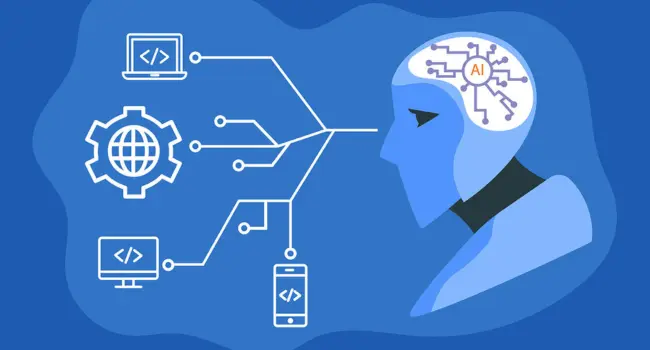Beginner’s Guide to AI & Machine Learning Basics
Artificial intelligence is defined as teaching machines to think and learn. This guide is a simple way to study AI for beginners. It provides a basic introduction to artificial intelligence and helps you grasp how it works. You will learn how to define artificial intelligence in simple terms. Artificial intelligence is now a part of daily life. It works in schools, family homes, and hospitals. It also benefits people such as factory workers, waiters, and engineers. These are often referred to as intelligent systems. The core basis of AI show how machines improve over time. This AI beginner’s guide will help explain how AI is developing. Artificial intelligence evolution is changing the world in smart and beneficial ways. What is AI & Machine Learning? AI and machine learning enable computers to get smarter. They learn by seeing examples, just as children do. Machine learning is part of artificial intelligence. It enables machines to learn from data rather than being told what to do. This is known as machine intelligence. Some systems employ artificial neural networks to identify patterns. These patterns help in making sound choices. The goal of AI is to follow human decision-making, but computers do not have views as we do. That is the boundary between AI and human intelligence. AI employs computer models to address issues. Deep learning technology enables machines to understand more. These AI-powered solutions improve daily life. They work together to build clever machines that combine human and machine intelligence. Types of AI & Machine Learning There are several ways for machines to learn and become smart. These methods are known as artificial intelligence or machine learning. Some machines learn from examples. Others identify patterns without assistance. Some people learn by trying things out. Another method for machines to learn is deep learning, which employs multiple layers. Each type allows machines to do a variety of activities. Together, they create intelligent tools that benefit people. These tools are utilized in various settings, including households, schools, factories enhanced by IoT in manufacturing systems, and hospitals. Learning about these types is critical for understanding how machines function and think. It also allows us to understand how things are employed in the real world. Three Types of Artificial Intelligence There are three types of artificial intelligence: limited, general, and powerful. A narrow AI, such as a voice assistant, performs a single task. It is also known as weak AI. These are restricted AI examples, such as Siri or Google Maps. AGI is smarter. It can perform a wide range of duties, much like a human. People continue to dream of AGI—it is a universal AI desire. AGI is still a concept. It is an aim. Strong AI is far more advanced. It may have human-like thoughts and feelings, but it does not exist. The types—AGI, ANI, and ASI—show how AI might develop in the future. Supervised Learning Supervised learning happens as machines learn from data that is marked. It’s similar to teaching a kid by showing the correct responses. The machine sees situations and learns patterns. These patterns are identified using machine learning methods. Some are known as methods of classification for sorting items. Others employ regression and classification models to make forecasts. We provide training data and labeling to the system so that it can learn. It employs logistic regression to account for binary or multi-class grouping. These are just techniques to sort or group items. Support Vector Machines is a common tool. It allows machines to arrive at intelligent decisions. Unsupervised Learning Unsupervised learning is when robots learn by itself. We give them no answers. They analyze the data and discover trends. This is similar to finishing a problem without a picture. They use clustering methods such as K-means sorting. These are useful for grouping items that are similar. The approach sorts persons or objects using clustering-based division. Machines also employ centroid calculations to find the center of each group. Machines may employ semi-supervised learning, which includes both labeled and unlabeled data. Unsupervised analysis enables us to identify hidden information in large data sets. Reinforcement Learning Reinforcement learning is similar to teaching a pet. The machine attempts something. If it does well, it receives a prize. If it fails, it incurs a penalty. In Real Life, this is referred to as reward and penalty. It learns by trial and error. Over time, the system determines which actions yield the best benefits. This aids games, robotics, and self-driving cars. Reinforcement learning teaches machines to make good decisions. It also helps machines improve. The computer learns through its own actions rather than being instructed what to do every time. It’s an enjoyable and effective approach to study. Deep Learning Deep learning is a sophisticated form of machine learning. It has numerous neural network layers. These layers aid the system in detecting patterns in images or sounds. Deep learning makes use of deep neural networks, which are similar to those found in the brain. Each layer contains small “neurons” that transmit messages. This is known as the multilayer perceptron. It learns using the backpropagation algorithm and backpropagation-through-time for long-term jobs. CNNs are image-specific networks, whereas RNNs and LSTMs are used to model memory and time. Real-world applications use models such as the LeNet architecture. Deep learning might be difficult to understand at times, hence it is referred to as a black box model. However, it is still very useful for smart professions such as translation, voice, and vision. History and Evolution of AI & Machine Learning The history of artificial intelligence and machine learning is extensive and intriguing. It started with brilliant individuals questioning, “Can machines think like humans?” Over time, numerous new concepts and tools emerged. This adventure has both highs and lows. Some years produced great success. Others were slower, dubbed AI winters. But intelligent brains never gave up. Today, artificial intelligence is rapidly expanding. The history of AI explains how we got here. Learning this helps you understand how machines are growing smarter. This
Beginner’s Guide to AI & Machine Learning Basics Read More »


